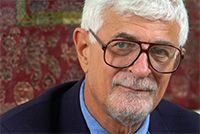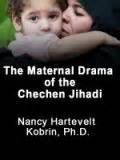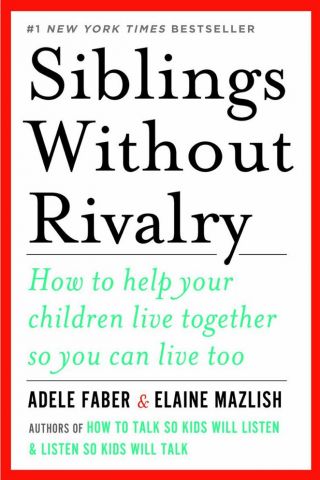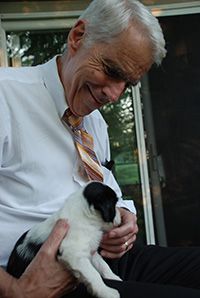
“Through his powers of intellect, articulate language has been evolved; and on this his wonderful advancement has mainly depended.”
– Charles Darwin, The Descent of Man, 1874 (p. 49)
Language
We are in the midst of exploring development and its three pillars: affects (feelings), language, and cognition. We concluded our investigation of feelings in the December 2014 Newsletter with a focus on anger. We now move on to language.
However… before we leave feelings entirely, we are honored to have a guest columnist, Nancy Kobrin, Ph.D., continue our discussion of anger. Dr. Kobrin is an internationally-known expert on the relationships between development, hatred, and terrorism. Her column appears at the conclusion of our usual newsletter.
So, on to the second of our three pillars: language.
Language has been described as one of humans’ most important evolutionary advances. We will explore language with specific reference to individual development and its relationship to affects and cognition.
So what is language? Let’s keep it straightforward. Merriam-Webster’s says language is: the words, their pronunciation, and the methods of combining them used and understood by a community; the audible, articulate, meaningful sound as produced by the action of the vocal cords; and a systematic means of communicating ideas or feelings by the use of conventionalized signs, sounds, gestures, or marks having understood meanings.
Language and Geological Time
First, however, we must put language in the context of geological time. According to the “Big Bang” theory, the universe expanded from an extremely dense state about 13.8 billion years ago. The earth and sun were formed about 4.6 billion years ago. Let’s now put our species, Homo sapiens, into this context. As the evolutionary biologist Ernst Mayr writes, Homo sapiens appears to have originated in sub-Saharan Africa about 150,000 to 200,000 years ago, deriving from African populations of Homo erectus (Mayr, 2001). DNA and fossil evidence currently suggests the following migration across the earth: “A wave of H. sapiens eventually broke out of Africa and spread rapidly over the entire world. They reached Australia some 50,000 to 60,000 years ago, eastern Asia 30,000 years ago, and North America reportedly about 12,000 years ago. There is, however, some evidence for an earlier colonization of America, possibly as early as 50,000 years ago” (Mayr, 2001, p. 250).
Animals, Humans, and Language: Darwin, Tomkins, and Mayr
Do animals express what we know of as feelings? As we discussed previously, Darwin, Tomkins, Mayr, and many others, argue that they do. “…it is now realized that many animals also show that they have emotions of fear, happiness, caution, depression, and almost any other known human emotion” (Mayr, 2001, p. 256).
But do animals have language? Here’s how Mayr addresses this question: “Even though we often use the word ‘language’ in connection with the information transmittal systems of animals, such as the ‘language of bees,’ actually all of these animal species have merely systems of giving and receiving signals. To be a language, a system of communication must contain syntax and grammar. Psychologists have attempted for half a century to teach language to chimpanzees, but in vain. Chimps seem to lack the neural equipment to adopt syntax. Therefore, they cannot talk about the future or the past” (2001, p. 253).
Darwin discusses the issue in more detail: “…all the higher mammals possess vocal organs, constructed on the same general plan as ours…” (1874, p. 92). Darwin also grappled with this issue in his wonderfully picturesque way by comparing other species to Homo sapiens: “The habitual use of articulate language is, however, peculiar to man; …That which distinguishes man from the lower animals is not the understanding of articulate sounds, for, as everyone knows, dogs understand many words and sentences. In this respect they are at the same stage of development as infants, between the ages of ten and twelve months, who understand many words and short sentences, but cannot yet utter a single word. It is not the mere articulation which is our distinguishing character, for parrots and other birds possess this power. Nor is it the mere capacity of connecting definite sounds with definite ideas; for it is certain that some parrots, which have been taught to speak, connect unerringly words with things, and persons with events. The lower animals differ from man solely in his almost infinitely larger power of associating together the most diversified sounds and ideas; and this obviously depends on the high development of his mental powers” (1874, p. 88).
There appears to be little data to help us understand the development of language during the approximately 200,000 years of Homo sapiens. How about writing? Writing involves the expressions of language by letters or other marks. Writing as we know it shows up about 5,000-6,000 years ago, and it was preceeded by various forms of numerical recording.
Before Children Talk, They Understand

“…infants, between the ages of ten and twelve months, …understand many words and short sentences, but cannot utter a single word.”
– Charles Darwin, The Descent of Man, 1874, p. 88

“By the time babies start to talk they have already acquired a great deal of world knowledge…”
– Daniel Stern, M.D., The Interpersonal World of the Infant, 1985(p. 168)
“…some senses of the self do exist long prior to self-awareness and language. These include the senses of agency, of physical cohesion, of continuity in time, of having intentions in mind, and other such experiences…”
– Daniel Stern, M.D., The Interpersonal World of the Infant, 1985(p. 6)
When we talk about the importance of language, we almost automatically think in terms of when the child begins to speak. But long before the child speaks, s/he is listening—and understanding far more than we used to think. We are talking about language and infancy—roughly the period prior to 1-2 years of age. “Infant” means incapable of speech—but it does not mean incapable of understanding speech. In fact, psychoanalytic researchers and clinicians, who deal with early parent-infant interactions, have begun to ask if there is any “nonverbal” period of development (Vivona, 2013). Why? Because, the baby is immersed in words as well as sounds from pregnancy onwards. So the idea is that words and affects and meanings combine very early on.
Next month, we will continue exploring the notion that children know a great deal of language before they can talk.
References for Interested Readers
Darwin C (1871). The Descent of Man, and Selection in Relation to Sex. London: John Murray. 1st Edition. The Descent of Man, and Selection in Relation to Sex. 2nd Edition. London: John Murray, 1874. Quotes from 2nd Edition, Amherst, New York: Prometheus Books, 1998.
Mayr E (2001). What Evolution Is. NY: Basic Books.
Vivona JM (2013). Is there a nonverbal period of development? JAPA 60: 231-265.
Guest Column: Nancy Kobrin, Ph.D.
The Prologue to Jihadi Violence Begins in Childhood
This all began when Dr. Paul and I were classmates at the Chicago Institute of Psychoanalysis in the early 1980s. To this day I find reading his Parenting and Child Resources Newsletter with Paul C. Holinger, M.D. enormously helpful for my work in counter terrorism.

In the last newsletter, attention was given to Anger. In terrorism, the affect of anger is known by its social equivalent as Hatred. The world renown psychoanalyst, Vamik Volkan, M.D., a Turkish Muslim who grew up in war torn Cyprus, stated that the need to hate and the need to have an enemy is learned behavior occurring in the home by age three. Some experts even believe that moral development occurs earlier, perhaps by age one, very similar to the acquisition of language. The mother is the cultural interpreter for the baby. See Prof. Aner Govrin, The ABC of moral development: An attachment approach to moral judgment, http://journal.frontiersin.org/Journal/10.3389/fpsyg.2014.00006/abstract.
Prior to my training in psychoanalysis, I had become immersed in the coexistence of the three Abrahamic faiths - Judaism, Christianity and Islam in medieval Spain. I studied Arabic and Old Spanish written in Arabic script, along with Hebrew and Latin. I had wanted to read the Quran and understand the Muslim communities who had lived there.
When people hear about my background in psychoanalysis, it may sound odd—but actually these areas of study interrelate and enhance one another concerning individual and historical trauma, violence, terrorism, and communal identity. Group psychology helps us understand group behavior; for instance, how the west is more dominated by the individual mind as opposed to the group mind of more repressive cultures. During the Middle Ages, the group self was also more important than the individual self. This knowledge came in handy when I shifted to studying the Jihadis, where the group self remains more important than that of the individual. At the Chicago Institute we studied child development, identity, and trauma. My interest focused on trauma, especially victims of terrorist attacks.
However, when the Islamic suicide truck bombs went off in Lebanon in the early 1980s murdering American and French troops, I began thinking about the mind of the terrorist. They bond or attach themselves to others through violence. They are terrified of intimacy. I came to look at them as if they were "little toddlers emotionally," trapped in adult bodies in play therapy. Yet I remained fully aware that this was not play.

My work depends a lot on practical experience. I do prison interviews, teach law enforcement and the military, both in the U.S. and abroad, even Sri Lanka. I immigrated to Israel four years ago, which has deepened my understanding of the Middle East. My third book, The Maternal Drama of the Chechen Jihadi (Boston Marathon Attack), brought me to the Ukraine recently to learn about the Chechen terrorists who are fighting there. This on-the-ground experience, coupled with years of training and clinical practice, had been invaluable.
Each terrorist speaks a unique unconscious personal "pantomime," acting out their emotions funneled through radical ideologies. Terrorists harbor a rage which exceeds murder itself. They are like serial killers in that they are obsessed with people, with the infidels. Killing once is never enough. They must kill repeatedly and dismantle the body through beheadings, and body parts etc.
Terrorists do not have empathy nor do they care to think about the meaning of their actions from a psychological point of view. They lack insight into their behavior. This reveals to us that they have a cognitive deficit. My hunch is they did not have anyone to help them understand their affective emotional life. The maternal attachment was at risk. This is not to blame the mother because growing up in a shame honor culture, she was the victim of chronic rage and abuse living under a death threat. Yet the terrorists did not learn to put their feelings into words, something that we take for granted in the west.
All the terrorist groups which have spawned suicide bombing have arisen out of shame honor cultures. Shame is the most powerful crippling emotion which makes one feel defective and full of rage. In these cultures, shame has become ritualized as acceptable. Shaming behavior is based on humiliating the other. It becomes "normalized."
Yet, can my theory help explain those converts to Islam who become Jihadis? I believe so—because even though they may have grown up in the West, my research suggested that child rearing practices entailed shaming in their dysfunctional families.
In shame honor cultures and families, the female is devalued. She has no standing in her community until she has a male baby. The baby is her narcissistic object of honor. Because of this, the baby is treated as an object, not as a person in his own right. Further complicating the familial dynamics is the fact that the mother was also devalued. She endured years of being the chronic target of rage and abuse.
In shame honor cultures, one can not get their needs met in an appropriate way. Needs are considered "dirty." Even a simple need like going to the bathroom can not be met in an appropriate way. These dirty needs are split off from the shamed self and projected onto the external object of hate. Another need concerns sexuality. In shame honor cultures, you can not talk about sex. It is highly repressed. For example, the honor killing concerns any hint of sexual impropriety and entails the murder of the female. The mother unconsciously communicates her annihilation anxiety to her baby. She will be murdered by her own family if perceived as having "dishonored" them.
The ironic tragedy is that the devalued female-turned-mother is the one who builds the brain of the baby. She can be thought of as Intel, the computer company. She "makes the computer chip" for the brain of the baby. Maternal attachment is key to understanding what went wrong during early childhood for these terrorists, along with genetics and epigenetics. It is not solely maternal attachment, but we know that terrorists did not develop empathy during the crucial time frame from in utero to age three. Again, I do not blame the female, whatsoever. I highlight the hardship she endures to raise her child in a calm hate-free environment.
Furthermore, in these instances, religious ideologies are often used by parents to dissipate their own anxieties by manipulating and controlling their children. Ideologies act as a girdle for a fragile personality. The rage resulting from not being listened to and empathically understood is funneled through the "religious pipeline" of beliefs. The mounting rage is projected outward onto the feminized Other. Ironically, parents who hate reveal to us that they grew up being shamed. Hatred masks terror of the Other. The trauma repeats itself across generations.
In 2010, I was interviewed for a documentary called Body Language (2012). Its director, Doïna Harap, contacted me after reading my first book, The Banality of Suicide Terrorism. I had developed a theory of imagery to explain terrorism's unconscious nonverbal communication. Ninety-five percent of what we communicate, we do so nonverbally. Harap interviewed a series of neuroscientists and experts on autism whose findings corroborated my descriptive analysis that terrorists lack empathy. These specialists also believe that something went wrong for the terrorists during early childhood. I described their disorganized attachment.
Terrorists are not aware of how revealing their behavior is. They are like a patient on a locked ward in a psychiatric hospital, who sits frozen and shivering. This patient can not tell us in words that he is emotionally freezing to death. He communicates his terror of freezing to death to us nonverbally. The terrorist is similar. The terrorist becomes the terror, as my good colleague, Joan Lachkar, Ph.D., has so aptly put it. The terrorist then projects into us his terror, terrifying us. If we know and understand this, we can see that the terrorists are terrified and, in turn, we will be less terrified. We still must keep in mind that they are predators. If we understand that they lack empathy, we can be more effective in profiling, setting limits, and intervening earlier.
Understanding childhood development is key to dismantling the political violence of terrorism. I continue to be interested in the interlocking links of its violence arising in the home and playing out under the rubric of political violence of terrorism. The problem lies dormant, somewhat hidden from sight of the untrained eye and seen only when the violence is triggered years later during adolescence through radicalization. In fact, they were radicalized long before. The radical for radicalization is grounded in early childhood development.
We are still in the early stages of understanding all the aspects of political violence. It is probably a volatile mix of genetics, neurobiology, and environment, with the latter's key component being the "nest" of the maternal attachment. We must remember four things concerning political terrorism of Islamic suicide terrorism:
- We are more alike than we are different.
- All behavior is potentially meaningful.
- Violence is violence. It does not care how we humans label it be it domestic violence or political violence.
- Everyone has a mother.
If you are interested in learning more about terrorism, I invite you to read my third book, The Maternal Drama of the Chechen Jihadi. It is a free download made available through a special book project by the well-known publisher of psychoanalysis and psychology, Jason Aronson. He invited me to write on any aspect of terrorism. It was a big honor for me, just as it is to contribute to Dr. Holinger's newsletter. My book is available at www.freepsychotherapybooks.org. If you look to the right in the margin, you can see that people are downloading books from all over the world—Saudi Arabia, Pakistan, Malaysia etc. The more we can educate and give people the tools to treat troubled children early on, the less violence there will be in this world. I hope you have found my contribution of interest.

Nancy Hartevelt Kobrin, Ph.D. is a fellow at the American Center for Democracy. She is a psychoanalyst, Arabist, and counter-terrorist expert. She has authored three books on terrorism. The Maternal Drama of the Chechen Jihadi is a free download at http://www.freepsychotherapybooks.org/. It contains an extensive bibliography on terrorism. Dr. Kobrin is at work on her next book, The Dictionary of Desperanto: How Terrorists Misuse Objects. She lives with her partner Professor Yitzhak Reiter, one of Israel's leading authorities on the Arab minority in Tel Aviv, and they have eight grandchildren.
References for Interested Readers
Strozier CB, Terman DM, Jones JW, Boyd K (2010). The Fundamentalist Mindset: Psychological Perspectives on Religion, Violence, and History. New York: Oxford University Press.

Pros and Cons: Controversy Follows The Elf on the Shelf
Have you read The Elf on the Shelf? Our colleague, Rick Herrick, points out the controversy which surrounds this book. Elphie reports good and bad behavior to Santa. Adherents of this book suggest this enhances positive behaviors. Others note that the feelings which cause the behaviors are neglected, resulting in a harsh rigidity and lack of ambivalence and decision-making. What do you think? Google has a lot of discussion about this.

There is also a parody of this book titled The Elf off the Shelf: Christmas Tradition Gone Bad (2011).

Vignette:
A Great Emotional Catch
The parents of Gail (4-year-old) and Susie (1-year-old) were out of town for five days, during which time the grandparents stayed with the children. When the parents returned, Mother asked Gail how it had gone. Gail responded it was fun, but she did scream a little because her parents were gone. Mother asked whether Gail apologized for screaming, and Gail said, “No.” Gail’s empathic aunt was there at the time and suggested that Gail probably screamed because she was distressed that her Mommy and Daddy were gone. Gail agreed, and Mother picked up on this, saying, “I’m sure you were upset and missed us, and we missed you very much!”
Dr. Holinger's Recommended Book of the Month

Faber A, Mazlish E (1987). Siblings Without Rivalry: How to Help Your Children Live Together So You Can Live Too. New York: WW Norton
This is a useful book for understanding siblings and their conflicts. The authors stress the importance of focusing on feelings—labeling and interpreting feelings—in order to help deal with sibling issues.

About Dr. Paul Holinger
Dr. Holinger is the former Dean of the Chicago Institute for Psychoanalysis and a founder of the Center for Child and Adolescent Psychotherapy. His focus is on infant and child development. Dr. Holinger is also the author of the acclaimed book What Babies Say Before They Can Talk.
Read more...




